Menus
- Police savagery
- 4 cylinders of 948 cm3, 125 hp and 98.6 Nm, 212 kg, 9.499 euros
- Discovery
- In the saddle
- In the city
- Motorway and expressways
- Departmental
- Part-cycle
- Braking
- Comfort / Duo
- Z900 video test
- Conclusion
- Test equipment
Police savagery
4 cylinders of 948 cm3, 125 hp and 98.6 Nm, 212 kg, 9.499 euros
Unmissable sales success in the midsize segment since its appearance in 2004, the Kawasaki Z750 and its Z800 and Z900 descendants have thrown the counters into a panic. The last one still sold 32,000 copies in Europe, half of which…. in France ! It actually flows 3,500 to 4,000 units / year in France, with equal distribution of version A and A2.
Over the years, Akashi’s bestseller has changed a lot. From the 748 cm3 at the start in its S and R versions, it then went up to 806 cm3 in the Z800 version in 2013. 5 years later, everything changed with the Z900. A profound change, the machine then displays 948 cm3 housed in a brand new tubular frame. You could almost call it 1000! We are far from the early average displacement roadster; Moreover, the first Z1000 cubed 953 cm3 in 2003….! In short, there is now almost confusion of genres.
For 2020, the new opus takes a little care of its style, always more “Sugomi”, associated with electronic evolutions and that of its instruments. And of course the Z900 is compatible with the Euro5 standard. And there is always a version of the roadster accessible to A2 licenses with a maximum power of 95 hp (70kW) and therefore restrictable to 35 kW..
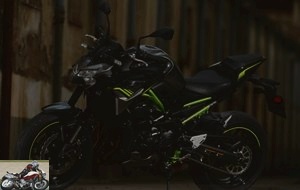 Kawasaki Z900 review
Kawasaki Z900 review
It is around Barcelona (Spain) on a route with contrasting reliefs, totally soggy and in pouring rain, that we discover the latest developments of the Z.
Discovery
Heir to the "Sugomi" style dear to Kawasaki, the Z900 is always inspired by the animal ready to pounce. Arrogant and a little flashy, sparsely covered and muscular, the Japanese do not tend to be consensual. Few developments on this subject. The general lines have been changed slightly to make the whole thing sharper and more compact. This is particularly the case with the plunging headlight block. This short muzzle fits into the broad shoulders of more streamlined scoops, paired with the prominent 17-liter tank. Curved like an animal spine, it gives movement and personality to the design. The whole remains faithful to the canon of the model and even allows itself a few additional Z embellishments, again at the level of the frontal optics. The latter, like all lighting, is LED, including "antenna" turn signals. The welcoming rider seat is dominated by a passenger folding seat, propelled on a sheathed rear loop and raised towards the sky. A light in Z signs the stern.
 Kawasaki Z900 headlight
Kawasaki Z900 headlight
Then there is an integral tubular steel chassis – already present in the previous vintage but now reinforced at the pivot of the swingarm – weighing only 13.5 kg, contributing to the agility of the roadster. The structure supports the same 948cc (73.4 x 56mm) 16-valve, twin-shaft, in-line 4-cylinder with four 36mm twin-throttle injection bodies developing 125 hp at 9,500 rpm and 98.6 Nm of torque at 7,700 rpm. To comply with Euro5, the exhaust has been revised to reduce emissions. Springs and clutch settings have been changed for more flexibility. Remember that the clutch is of the "Assist & Slipper" type, making the lever more flexible and allowing gears to be stacked when downshifting. Two types of cams (a locking cam and a sliding cam) compress or separate the pressure plates from the clutch housing. In the event of excessive engine braking (downshifting too fast), the sliding cam comes into action. It separates the pressure plates from the clutch housing. This relieves the force exerted on the clutch discs, limiting rebound as well as locking the rear wheel..
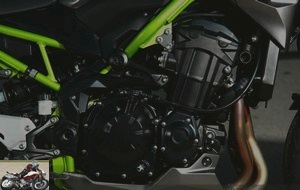 Kawasaki Z900 engine
Kawasaki Z900 engine
It is especially at the level of electronics and assistance that the Z900 opus 2020 evolves. Its mechanics, managed by a cable accelerator, in no way prevent the roadster from receiving its battery of chips. The Kawa is now equipped with the KTRC house anti-skid system (by ABS sensor), adjustable on three levels and deactivatable, two power modes (Full and Low / 55%) associated with four driving profiles. They are the ones who control the electronics. Thus, three pre-set modes (Sport, Road and Rain) adjust the KTRC and power variables, Also, a fourth personalized setting (Rider) allows each of the data to be chosen independently of one another from the console to the left chest of drawers. The Rain setting reduces engine capacity by 55%, modulates throttle response and places the KTRC in position 3, the most intrusive.
The four-in-one ends with an asymmetrical silencer which adjoins a beautifully crafted aluminum swing arm entrusted to a horizontal rear suspension adjustable in preload and rebound and deflating over 140 mm. Of the "Back-link" type, this assembly keeps the element away from the heat of the mechanics and contributes above all to the centralization of the masses, both for the combined unit and the exhaust. The space freed up under the machine allows the (heavy) catalyst to be placed there..
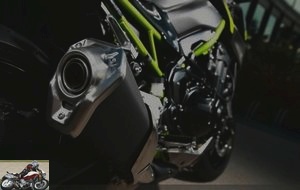 Kawasaki Z900 silencer
Kawasaki Z900 silencer
The steering gear benefits from an inverted fork of 41 mm adjustable in preload and rebound, sliding on 120 mm. 4-piston calipers are attached to drive semi-floating 300 mm discs. The opposing uni-piston gripper bites a single 250mm element. Everything is under ABS control. 17-inch five-spoke aluminum rims accommodate dedicated tires. These Dunlop Sportmax Roadsport 2 in 120/70 and 180/55 are offered as original equipment. Modified in sculpture, it is the evolution of the previous D214. To see in dynamics.
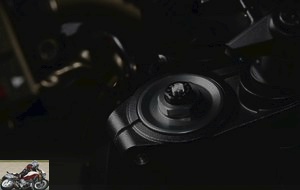 Kawasaki Z900 fork adjustment
Kawasaki Z900 fork adjustment
The geometry of the Z900 evolution 2020 admits values that take greater care of stability: wheelbase of 1.455 mm (+ 5mm), column angle of 24.9 ° (+ 0.4 °) and trail of 110 mm (+7 units). However, nothing to hamper the dynamism of the chassis, even with a slight increase in weight. With its 212 kg (+2), the roadster remains a high displacement machine with a low weight..
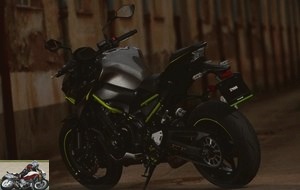 Kawasaki Z900
Kawasaki Z900
The Z900, naked as it is, also takes care of the details. Cables and hoses are mostly hidden and two half-shoes protect the lower part of the Japanese block. Housings, plates and other metallic elements feature flawless surfaces. Slender, the side stand seems to me to have an insufficiently wide support to ensure optimal stability on any surface. Beware of stationary falls on unstable ground or on a slope. Finally, although hidden under the machine, the catalyst remains quite noticeable and very unattractive. Maintenance intervals are 12,000 km.
In the saddle
The 2018 Kawasaki Z900 placed its saddle at 795 mm. Value considered too low, even by small templates (!), Then removed from the handlebars by the prominent tank. The roadster raises its seat by 25 units, placing your seat at 820 mm. Fortunately, the arch is narrow, which allows the Z to remain accessible while offering a more efficient position; now slightly more tilted on the handlebar with little marked lugs, the pilot thus benefits from better support on the handles. Less pleasant, the voluminous tank still separates the legs significantly. Good point, the levers are adjustable in spacing.
 Ergonomics of the Kawasaki Z900
Ergonomics of the Kawasaki Z900
It should also be noted that the Z900 benefits from "ERGO-FIT", a Kawasaki system allowing pilots to adapt the ergonomics of their machine. Various elements (handlebars, footrests, saddle, etc.) can be adjusted through a combination of interchangeable parts and adjustable parts. A principle that the eventual passenger will not have to do with the absolute hardness of his saddle. The pilot is better off on a softer cushion. Sportiness requires, its footrests are significantly set back, legs bent, contributing to a dynamic position. But without excess.
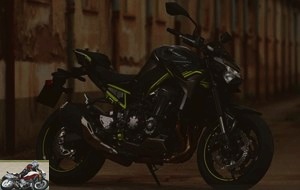 The Kawasaki Z900
The Kawasaki Z900
In front of the eyes, finally readable instruments! A brand new 4.3-inch color TFT screen, with automatically adaptable brightness, now displays the gear engaged and bargraph tachometer dominating a tachometer, a fuel and engine temperature gauge, clock and, by successive presses on the switch of the commodo left, partial, odometer, average and instantaneous consumption, range, average speed and battery charge. The motor modes are controlled in the same way. Too bad, you have to wait a little long to change it. A dedicated button would have been more effective.
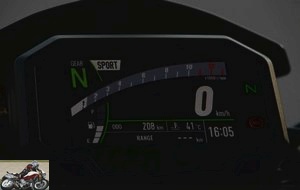 Kawasaki Z900 speedometer
Kawasaki Z900 speedometer
The instruments also offer extensive functionality. In detail using the smartphone app "RIDEOLOGY THE APP", information such as fuel gauge, odometer, maintenance schedule, etc. can be viewed on smartphone. The Riding Log functionality displays the route and engine speed there. Connected via Bluetooth, you will even receive your emails or text messages…. When "the essential" competes with "the essential". Finally, the general parameters of the instrumentation (distances, date, etc.) can be adjusted via the smartphone. More useful, this quality equipment records your GPS routes. Finally, the display offers a dark or white background, the latter is more pleasant and ideal to avoid reflections.
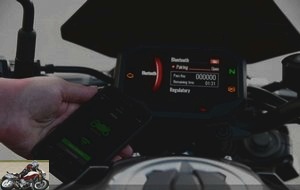 Kawasaki Z900 Rideology App
Kawasaki Z900 Rideology App
In the city
The four-cylinder comes to life with an ample, lively yelp. The sportiness of the block is immediately noticeable. Rather pleasant for a Euro5 machine, the exhaust does not filter the chanting of Akashi’s boiler too much. The latter quickly takes off the crew with a deceptive roundness. In the pouring rain, the rain mode is activated, smoothing the impetuosity of the animal. The softness and mechanical availability of the Z900 are appreciable in urban development. We then stay in sixth gear, the machine picking up easily at the idle speed limit of 35 k / h. On this subject, the injection demonstrates a rare precision, leaving a perfect control of the acceleration. Like what a good old cable to wind … I say that, I say nothing.
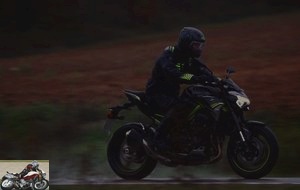 The Kawasaki Z900 on the wet road
The Kawasaki Z900 on the wet road
Equally attractive, the butter / cream type clutch and a precise selection contribute to the overall ease of handling the machine. The latter benefits from an obvious cycle part and an excellent balance. Less appreciable between the walls, the turning radius remains a little wide for tight U-turns.
The roadster barely vibrates, leaving its mirrors free from fuss. Could we have muzzled the ugly beast Sugomi? Nay, open the urban cage and you will see.
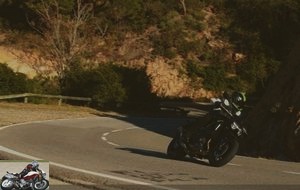 Curve exit with the Kawasaki Z900
Curve exit with the Kawasaki Z900
Motorway and expressways
I quickly switch back to Road mapping, then regaining the assertive character of the Z. The anti-skating is watching, I am confident. However, the driving character is a reflection of the style of the roadster. The almost 1,000 cm3 of the Z900 are amplified by 98.6 Nm of torque and 125 barely shy horses which tumble down on the soaked Iberian asphalt. Obviously the rear envelope slips, even in a straight line. But the KTRC regulation is immediate and gentle, ensuring a safe intervention.
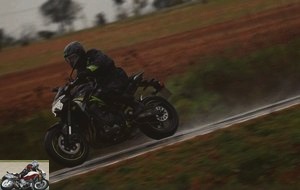 Kawasaki Z900 road test
Kawasaki Z900 road test
While cruising on the legal motorway, the Kawa boiler is right at its mid-range, ie 5,500 rpm on the last report. Tingling runs through the machine but does not generate any discomfort. The revivals are then dynamic but entering a report propels the crew with all the ardor of the four cylinders. Our driving conditions have limited the play of maximum speeds. And the roadster does not encourage long straight and priced journeys anyway..
Departmental
Storm announced over Catalonia. In fact, it’s raining more and more severely on our track. Ideal for making us test electronic novelties. Variable maps and traction control then take on their full meaning on a machine so strong in mechanics. And their implementation is most convincing. On certain reminders, the start of a comma is quickly suppressed, without any sudden or unforeseen reaction. Responsive in rain mode, the KTRC leaves less headroom in Road setting. We then benefit from a more available engine but without being surprised as the accelerator is so precise. Better, your Rider customization can combine Road mode and KTRC level 3 (the strongest). What to adapt the reactions of the machine to your wishes and driving conditions.
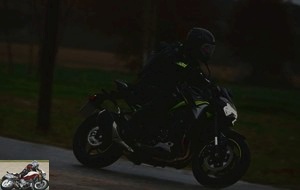 The Kawasaki Z900 on a curve
The Kawasaki Z900 on a curve
Under terrible weather, the overall smoothness of the whole machine remains appreciable and surprising at a steady pace. In every sense of the word…. On high gears we wind up the soggy curves, guided by a precise and neutral steering gear. The feeling of control and naturalness of the front is noticeably enhanced by the modified riding position. Dominating his machine more, the pilot thus better controls his evolutions. What a frustration not to be able to take this obvious and reactive cycle part more dynamically, both on the handlebars and on the footrests. Especially since the damping seems effective and in accordance with a removed rhythm. But the width of the tank is always a little excessive to give maximum ease..
 The Z900 entering a corner
The Z900 entering a corner
The accelerator / engine connection is rented out again, especially on bends during go-arounds. Here again, the high precision of the injection delivers perfect control of the acceleration. Likewise, it is easy to keep a trickle of gas on the angle and the raises are done without any jolts. A stone in the garden of the MT-09…. The only downside to this serenity, the new original tires still seem to us to be perfect. Carcass still too rigid no doubt and sport design do not contribute to a good feedback of information or a correct grip. It moves and it slides.
When the grip of a more granular and less humid asphalt passes us under the wheels, we take the opportunity to make the four-cylinder roar more. And especially its air box which furiously communicates the life of the Kawa block. At the time of Euro5, a little sound pleasure is a challenge. Beyond 6,000 laps, the block becomes wild and ample, recalling its appreciable sportiness. Again, no touch today. Just enough to delight our senses on rare occasions.
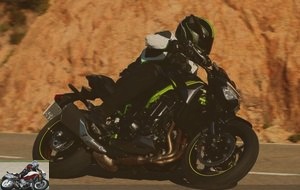 The Kawasaki Z900 on the dry road
The Kawasaki Z900 on the dry road
And what to use the brakes. The attack of the front calipers on the discs is very frank as evidenced by the rapid depression of the fork at the start of the race. But the elements retain very good braking control. The decelerations are easily modulated and the ABS is as efficient as it is discreet when it is started. Also, the hydraulics of the front axle then precisely manages the plunging of the tubes..
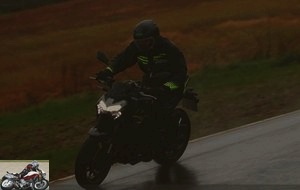 The Kawasaki Z900 under braking
The Kawasaki Z900 under braking
Part-cycle
With its rigid and light trellis frame present since 2018, the Z900 delivers first-class driving pleasure. Suspensions and geometry combine to make the roadster an agile, precise and lively machine. The new position induced by the saddle gives a better feeling and control of the front axle.
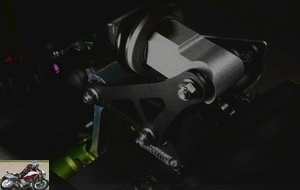 Kawasaki Z900 shock absorber
Kawasaki Z900 shock absorber
Braking
Be careful, it bites. Akashi’s Beast doesn’t pretend and the pitchfork is a testament to that as well. We will adjust the preload to the left tube. Powerful but flexible, the decelerations very correctly muzzle the outbursts of enthusiasm of the Kawasaki cyber-animal. The ABS keeps watch effectively. Enough to drive hard, correcting the trajectories with the efficient rear clamp. However its race is a little short.
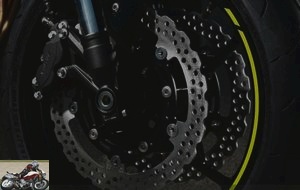 Kawasaki Z900 front brake
Kawasaki Z900 front brake
Comfort / Duo
Passenger comfort is therefore, pun intended, of short duration. From one end of a street to the other. Too bad, his sitting position is rather pleasant. Plan a cushion and, above all, a (very) small ass for your companion. Fortunately, for the pilot, the situation is much better. Apart from a recoil which is always a little tight, the ease on board remains correct.
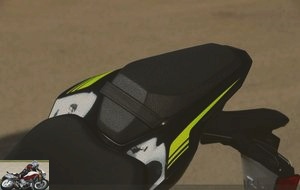 Kawasaki Z900 seat
Kawasaki Z900 seat
Z900 video test
Conclusion
Despite weather conditions limiting our analysis, the Kawasaki Z900 evolution 2020 significantly improves its driving pleasure. The riding position is, in my opinion, an important step forward in its handling and control. Its quality electronics with flawless implementation really optimizes the pleasure, efficiency and safety of this character roadster. Incisive since 2018, the cycle part perfectly follows the requirements of mechanics with a strong personality. A new opus that will undoubtedly continue to thrill the competition. Starting with the Z 1000, the future of which we can wonder. Caught between this high-pretension sister and a far more dynamic ZH2 to come, the old Kawa reference loses its legitimacy.
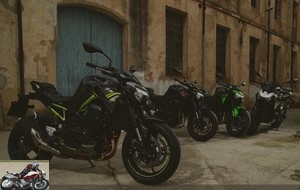 The colors of the Z900 for 2020
The colors of the Z900 for 2020
Because the Z900 plays at two tables at the same time. Between the midsize it is no longer and the 1000cc or more it is not quite. Thus, many competitors play on a segment lower in displacement, but…. comparable in price. The Suzuki GSX-S 750 asks for € 8,899 and the GSX-S 1000 € 12,899. Outra-Manche, the Triumph Street Triple 765 and its bewitching 3-cylinder, equally powerful but lighter, certainly claims € 11,900 when a luxurious Honda CB 1000 R Neo Sport Cafe demands € 13,449. The direct enemy Yamaha MT-09 fetched € 9,199. Now with efficient electronics, the Z900 will impose even more its superior mechanics, for a price of 9 499 €. (A2 model: € 9,199 (€ 8,999 introductory price until March 31, 2020)
Strong word from the Kawasaki firm for its Z900: Dominant. Over the years, the manufacturer has kept control of the essential large roadster market. This evolution of his Z900 has now seduced me, despite a traditional Sugomi aesthetic that I do not necessarily validate. Efficient and demonstrative, the Akashi bug may well continue to dominate the market. To be confirmed by a dry test.
Strong points
- Engine character and availability
- Agility and efficiency
- Braking
- Quality of suspensions
- Efficient electronic assistance
- Precise selection
- Sound
- Instrumentation
Weak points
- Ultra hard passenger seat
- Vibrations during certain piloting phases
- Large tank
- Uninviting side stand
- Original tires
Kawasaki Z900 technical sheet
Test conditions
- Itinerary: winding roads with variable surfaces, wet
- Weather forecast: rain galore
- Motorcycle mileage: 120 km
- Problem encountered: ras
Test equipment
- Roof R0200 Carbon Helmet
- AllOne Apex LT Jacket
- Jean Vanucci Armalith 2.0
- Vanucci Touring IV Gloves
- Vanucci VTB 20 Boots
- Proof rain jacket – C.Breaker II
Related articles
-
998 cm3, 210 hp at 13,000 rpm, 11.3 m / kg, 300 km / h, 206 kilos, € 17,799 Breathtaking performance, cutting-edge electronics, pure feel… You may not…
-
Ninja cyborg, the ultimate warrior After her victories in the Superbike championship, Kawasaki delivers a new, even more cybernetic opus of its Ninja…
-
4 cylinders in line, compressor, 998 cm3, 210 hp at 11,000 rpm, 137.3 Nm at 9,500 rpm, 260 kilos, € 21,999 Kawasaki reinvents the super-fast and…
-
4 cylinders in line, 948 cm3, 111 hp at 8,500 rpm, 10 m / kg at 6,500 rpm, 215 kilos, from € 11,999 A skillfully modified Z 900 or the worthy heir to the…
-
Kawasaki Ninja 1000 SX motorcycle test
Compromise without compromise 4 cylinders of 1,043 cm3, 142 hp and 111 Nm, 235 kg, from 14,349 euros In 2010, Kawasaki presented its first Z1000SX, a…
-
A new little sports car accessible to A2 licenses Twin cylinder in-line, 399 cm3, 45 hp at 10,000 rpm, 38 Nm at 8,000 rpm, 168 kilos, from € 5,999…
-
40 horses at 11,500 rpm 25.7 Nm, 175 kilos with full tank, two colors, € 5,799 An easy and sparkling little trail: what if life on a motorcycle was as…
-
Kawasaki Versys 650 motorcycle test
Twin-cylinder 649 cc, 69 hp, 210 kilos, A2 version, euro5 ready Daily test 2006, the year of the successive revivals of Kawasaki on segments where we…
-
Kawasaki Ninja ZX-10R motorcycle test
The good vein 4 cylinders in line, 998 cm3, 203 hp and 11.7 mkg at 11,400 rpm, 206 kg all full, 19,399 euros. Who has not had their adored sportswoman,…
-
Evolution or revolution of the ER6-f with the in-line twin of 649 cm3, 68 horsepower for 193 kilos A more sporty look but, paradoxically, a gain in…
€ 6,300 for the CB500F, Honda does not sell off its roadster.
Unlike Suzuki which displays its SV650 – bridle in A2 – for 300 € more. And releasable at 76 hp, it.
Good after, the tastes and the colors…
Hello, there is still one thing I would like to know, which is why they put a 19 "wheel on it? This bike is a road bike, it is not made for tt. A shock absorber with a hydraulic adjustment would have been more useful (I’m on my 2nd 500X. Perhaps this will be the 3rd … After testing)
Even if it means comparing 3 motorcycles which have only the engine in common, it would have been necessary to put the 500 Rebel in this test.
All bikes brake really well today, it all depends on its use
The wheel of 19 perhaps allows them to gain a little ground clearance without touching the fork, so production line and assembly identical to the other models? (would have to confirm if the forks are identical on the 3, but I would find that logical)
On the contrary, honda wishes to give greater versatility to its 500 X. It is therefore logical to find a 19 inch wheel..
The suspensions are very correct.
raaaaaaaah
advice to experts:
the 690SMC overcount to death (like 8000 bullets for a 6-year-old grindstone). do you think the release of the news is going to bring the prices down a bit?
we agree that the 701 is "the same" as the old one, you think it will keep the rating like the old one?
tom4, because hey, 11k € the toy, it’s still expensive
Here, first comment and it’s Tom4 … "weird"…
It will inevitably influence the price of the occasion. But not the masses. Well, the LC4 final release is really great, the electronics … why not, but in absolute terms, it was a good bike since 2014, it will remain so in 2019. Here it is.
Merki 🙂
tom4, so finding a post 2014 is better